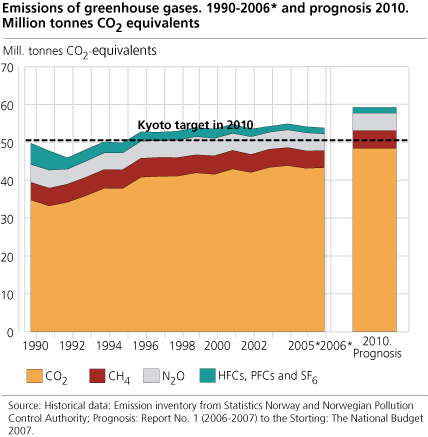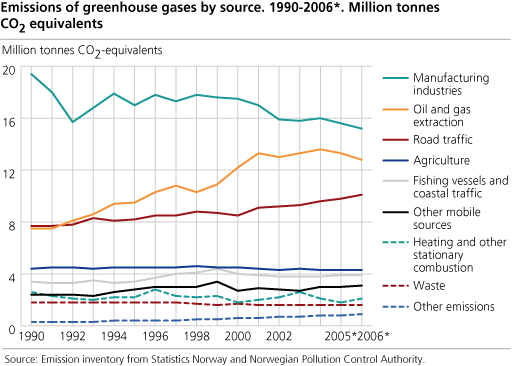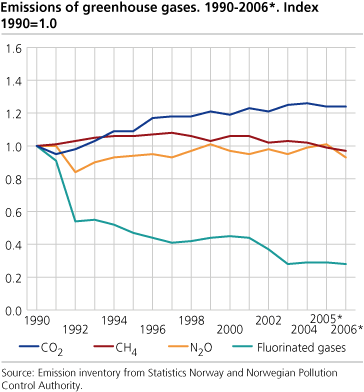Content
Published:
This is an archived release.
Greenhouse gas emissions down 0.8 per cent
For the second successive year, greenhouse gas emissions fell in 2006. The 0.8 per cent decline is partly due to reduced oil production on the continental shelf and lower production and environmental measures in parts of the emission-intensive manufacturing industries.
This appears from new preliminary emission figures produced by Statistics Norway in close co-operation with the Norwegian Pollution Control Authority. The uncertainty in the figures is discussed later in the article.
Norwegian greenhouse gas emissions totalled 53.7 million tonnes CO2 equivalents in 2006. This is 0.8 per cent less than in 2005. In the period 1990-2006, the emissions increased by approximately 8 per cent. Most of the growth took place in the period up to 1999, whereas the emissions in the following years have been rather stable. During the last two years, the emissions have declined and were slightly below the 1999 level in 2006. However, the emission level is expected to increase when the gas power plant at Kårstø and the gas treatment plant at Melkøya are put into operation in the near future.
The manufacturing industries, oil and gas activities and road traffic are the most important contributors to greenhouse gas emissions in Norway, and these sources were responsible for more than 70 per cent of the total emissions in 2006.
What caused the reduction?
The emission reduction in 2006 is mainly due to two of the major emission sources, namely manufacturing industries and oil and gas activities. The decline is caused by a combination of reduced activity levels and environmental measures.
Reduced emissions from activities on the continental shelf came as a result of lower production of oil and gas - the gross production in 2006 was 5 per cent below the 2005 level. Reduced production led to reduced energy needs, and accordingly less use of turbines. In addition, there was less flaring of natural gas.
Emissions from the manufacturing industries were 2 per cent lower in 2006 than in the preceding year. These emissions stem from either combustion of energy (for heating, production of hot water etc.) or production processes (e.g. emissions from the chemical processes arising during aluminium production). Emissions from combustion increased, probably because the ratio between oil and electricity prices made use of oil products more profitable than use of electricity. The process emissions were reduced, however. The main reason was the closing down of two metal producing plants and a general decline in other metal production. Furthermore, emission reducing measures have been introduced, e.g. in the production of fertilizer.
Transport and heating dampened the decrease
The emission decrease was counteracted by more use of oil products for both stationary purposes and transport. The use of heating oils and other fossil fuels in households and manufacturing and other industries increased considerably in 2006. The main reason for this is probably that very high electricity prices made use of oil products more profitable (for more information, read more here ).
The emissions from road traffic were still increasing in 2006, due to general traffic growth. Emissions from petrol have been somewhat reduced, but there has been a strong increase in emissions from diesel, because of more use of diesel vehicles and increased heavy traffic. In 2006, sales of auto diesel were higher than sales of petrol for the first time.
Due to higher activity levels, the emissions from domestic air traffic also increased in 2006. It may appear that there has been a reduction in emissions from fishing, while other domestic sea traffic has increased, but the figures are still too uncertain to draw a definite conclusion.
Manufacturing most important, but emissions decreasing
Manufacturing industries accounted the largest share of the emissions in 2006 with 28 per cent. Contrary to the other major emission sources, there has been a significant reduction in emissions from manufacturing industries since 1990. The decline from 1990 to 2006 equals 22 per cent or 4.2 million tonnes CO2 equivalents, which corresponds to the emissions from 3-4 gas power plants (Kårstø size), without CO2 cleansing. This is in spite of increased CO2 emissions in several important manufacturing industries due to production growth. The reason for reduced overall greenhouse gas emissions in the manufacturing industries, is lower emissions of PFC (perfluorocarbons) and SF6(sulphur hexafluoride), resulting from production of aluminium and magnesium, respectively. The emissions of these gases have been reduced considerably because of specific measures, such as transition to less polluting production technology and improved process control. In addition, the production of magnesium, which caused SF6 emissions, was closed down in 2006.
Half came from oil and gas activities and road traffic
Oil and gas activities contributed with approximately 24 per cent of the emissions in 2006. Contrary to the manufacturing industries, the emissions from oil and gas activities have increased considerably since 1990. The emission growth amounts to 70 per cent, whereas the total gross production of oil and gas has been more than doubled from 1990 to 2006. While net gas production is still increasing, the production of oil has declined in recent years. Oil production peaked in 2001, when it was 98 per cent higher than in 1990.
Emissions from road traffic, which constituted 19 per cent of the total emissions in 2006, have increased by 30 per cent in the period 1990-2006. Particularly the emissions from vans and lorries have increased, by somewhat over 50 per cent during the period. The growth can be related to both increased economic activity and higher consumption. The emissions form private cars have increased by 8 per cent, while total mileage has increased by 25 per cent. Accordingly, there has been considerable improvement in energy efficiency in the private car fleet, particularly among petrol cars. The transition to more diesel cars has so far been of less importance. In 2006, 17 per cent of the private cars were diesel vehicles.
CO2 the main problem
Greenhouse gases include the six gases covered by the Kyoto Protocol (see box): Carbon dioxide (CO2), methane (CH4), nitrous oxide (N2O), hydrofluorocarbons (HFCs), perfluorocarbons (PFCs) and sulphur hexafluoride (SF6) ( read more ). In 2006, CO2 made up more than 80 per cent of the greenhouse gas emissions by tonnes CO2 equivalents (compared to 70 per cent in 1990), whereas methane and nitrous oxide together constituted 17 per cent. The fluorinated gases amounted to 3 per cent of total emissions in 2006. Since 1990, CO2 emissions have increased by 24 per cent, whereas emissions of fluorinated gases have been reduced by 73 per cent.
Preliminary figures
The figures presented in this article are preliminary, but can be regarded as quite certain, particularly with regard to the total emissions. Detailed tables with distributions between source and industry will not be published until February 2008.
The Kyoto Protocol and Norway's obligation171 countries have so far ratified the Kyoto Protocol (6 May 2007). 37 of these, including Norway, will be assigned a national emission amount for the period 2008-2012. If the countries' emissions exceed the assigned amount, the so-called Kyoto mechanisms must be used to acquire further emission permits. These mechanisms include purchasing emission rights from other industrialized countries that have been assigned a national quota, or financing approved projects for emission reductions in developing countries (CDM - Clean Development Mechanism). Norway's emission amount is expected to be approximately 251 million tonnes CO2 equvivalents (1 per cent more than the 1990 emission for each year 2008-2012). In 2006, Norway's greenhouse gas emissions totalled 53.7 million tonnes CO2 equivalents. Projections made by the Norwegian Government indicate that Norway's emissions will increase from 53.7 million tonnes CO2 equivalents in 2006 to 59.2 million tonnes in 2010. If the emissions remain on the 2010 level in the whole Kyoto period, Norway will have to buy emission quotas in the range of 45 million tonnes for the period 2008-2012 as a whole. The projections for 2010 do not include overall emissions of up to 2 million tonnes CO2 from the gas power plants at Kårstø and Mongstad. The CO2 handling at the two power plants are at present not expected to be up and running until 2011/12 and 2014, respectively The Government has announced the proposal of sector specific climate action plans within the first half of 2007. The Government has also announced a national target for greenhouse gas emissions in 2020 by the end of 2007. |
Figures for acidifying gases also published
Documentation of the emission accounts
Tables:
This page has been discontinued, see Emissions to air, Annually.
Contact
-
Trude Melby Bothner
E-mail: trude.melby.bothner@ssb.no
tel.: (+47) 40 81 14 25
-
Berit Storbråten
E-mail: berit.storbraten@ssb.no
tel.: (+47) 40 81 14 23



